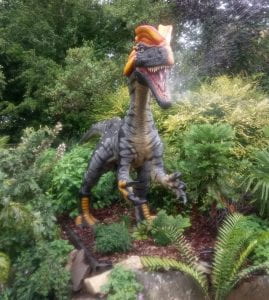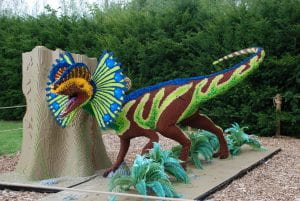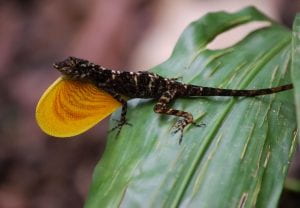Today is the 5th November, the annual British holiday of blowing things up to celebrate things not being blown up. Seeing as it is such a flashy vibrant event, I’m turning my attention to what is perceived as one of the flashiest and showiest of the dinosaurs; a star of Jurassic Park, Dilophosaurus.
Thanks to the role this dinosaur played in that 1993 blockbuster, everyone knows beyond doubt exactly two things about Dilophosaurus: it had a big frill on its neck to scare prey, and it was the dinosaur that could spit venom. Now given that the first word of this post title is literally “Misconceptions”, can anyone guess what I’m about to say?
Those two ‘facts’ about this particular American dinosaur are so ingrained in the minds of the public that they’re very hard to shake despite science having known since before the books that neither of these things were true. It doesn’t help how often this image of the animal is presented to us either. Even us at the BDP have to put our hands up and confess to being guilty of pandering to these myths.
In the past we’ve worked alongside Bristol Zoo Gardens, acting as the palaeontological consultants for the ‘DinoMania’ event of 2017. This featured life-sized animatronic dinosaurs which were, for the most part, pretty decent. One of these dinosaurs had a party trick of shooting water from its mouth, wanna guess which species that was?

Furthermore, in the summer just passed, we gave consultancy help to Marwell Zoo for their ‘Brickosaurs’ event, featuring LEGO recreations of some iconic extinct species. Naturally this meant having a Dilophosaurus with a full ornamental crest and (what else?) a system to make it spit water.

Now, we didn’t make these models of course, and were simply provided with them by external companies to do with what we could. But it’s still hard not to feel guilty and that we are actively promoting this fallacy of fictional functionality, even if we write signs explaining the mistruth, and have people on the ground to explain it, the damage is often done simply by having it there to see.
The misconceptions about the frill and venom spitting are so often discussed that one other glaring fallacy is let slide. The Dilophosaurus in Jurassic Park is actually much smaller than the real thing. Considering the series as a whole is more famous for hugely inflating the sizes of the stars (Velociraptor, the Mosasaur… oh god the Mosasaur…) this is surprising.
In Jurassic Park, the Dilophosaurus is depicted as being quite significantly smaller than a person, whereas the real thing was far bigger, reaching nearly 20ft in length. If he were encountering the actual animal I’m not quite so sure the character of Nedry would have attempted to play fetch with it.
Another issue is a lot easier to miss. While some dinosaurs did have the classic three-clawed look we tend to associate with them (Allosaurus, Giganotosaurus, the monstrous Therizinosaurus) many of the species lower down in the family tree actually had more. Dilophosaurus had some of these more primitive hands, still having four fingers. In fact, the earliest dinosaurs retained five complete digits on their hands.
So what exactly did Jurassic Park get right about this dinosaur? For starters we have to be fair and acknowledge that Dilophosaurus lived about 190 million years ago, making it one of the very few dinosaurs featured in the film to have actually been alive during the eponymous Jurassic period. A strike rate of two out of seven is… well, they tried… sort of.

Other than this they got a few of the basics right. It was a biped, it was a carnivore, it did have two large frills on top of its head. These frills are where the animal gets its name, Dilophosaurus meaning ‘Two-crested lizard’. This raises one of the most engaging questions about this dinosaur, what was their function?
The most likely reason is for a form of sexual selection. Many animals today use analogous structures, the colourful dewlap of an Anolis lizard being an obvious example. It too was likely coloured brightly, advertising what a strong and healthy individual the animal was.

However, like almost all traits evolved for sexual selection, they may have come at a cost. Despite the obvious of making the animal more visible to predators and prey alike (being ten-foot tall also likely didn’t help), they were also relatively fragile. A biomechanical study on a similar species in 2015 showed that they couldn’t take much stress before they’d fracture. It’s likely then that competing Dilophosaurus would resort to violence only as a last resort, preferring to use visuals and vocals so as not to risk their favourite feature being damaged.
Other studies continue to search for answers to questions about how the animal may have lived and hunted. Some of the most recent research tested the range of motion in the predators’ forelimbs to see how well it could use them. The results were an emphatic ‘okay I guess’. Dilophosaurus was unable to move the elbow beyond a right angle to the humerus, and the wrist mobility was also somewhat limited.
This isn’t what you’d expect from an animal that hunted with its claws, like a modern lions or tigers. Instead it likely means that when a Dilophosaurus went hunting, it was all about the teeth.
Even with that limited shoulder flexibility, the public and scientific worlds alike have a fondness for Dilophosaurus. There’s something about a big toothed, funky frilled, dinosaur that is impossible to resist. In 2017 the people of Connecticut even made it the official dinosaur of their state in, what I don’t need to tell you, was probably the most important electoral vote of the last decade.
Disclaimer– I’ve dragged Jurassic Park quite a lot in this post, and you’d be forgiven for thinking I was not a fan of the film. But I assure you it’s very much the opposite. I adore the film and the book, attributing it as one of the major reasons I’m a palaeontologist today. I only correct mistakes with love and respect. When it comes to the misconceptions of the Jurassic World films however…
Rhys Charles is the Engagement Officer for the Earth Sciences department of the University of Bristol, and has headed the Bristol Dinosaur Project since 2016.
Article edited by James Ormiston
References
Jurassic Park (1993) dir. Steven Spielberg Universal Pictures.
Dodson, P. (1997) Raising the dead. Science. 277: 644 – 645
Galis, F., Kundrát, M., & Sinervo, B. (2003) An old controversy solved: bird embryos have five fingers. Trends in Ecology & Evolution. 18: 7 – 9
Hone, D. W. E., Naish, D., & Cuthill, I. C. (2012) Does mutual sexual selection explain the evolution of head crests in pterosaurs and dinosaurs. Lethaia. 45: 139 – 156
Xing, L. et al. (2015) Model-based identification of material characteristics of Sinosaurus (Theropoda) crests. Acta Geologica Sinica. 89: 1 – 11
Senter, P. J. & Sullivan, C. (2019) Forelimbs of the theropod dinosaur Dilophosaurus wetherilli: Range of motion, influence of palaeopathology and soft tissues, and description of a distal carpal bone. Palaeontologica electronica. 22: 2 – 30

